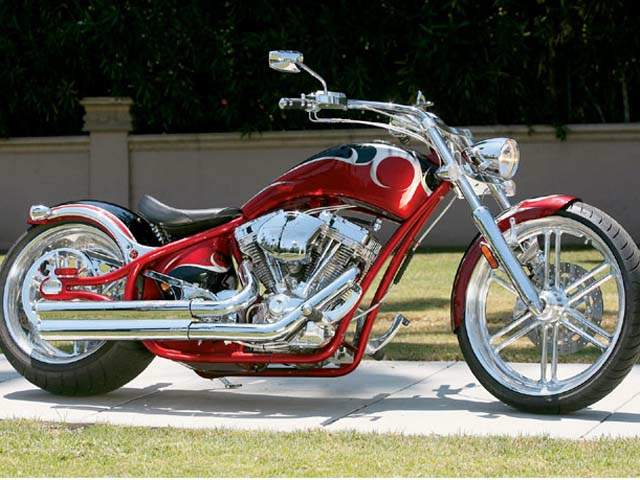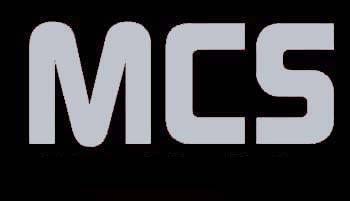Big Dog Pitbull

|
Make Model. |
Big Dog Pitbull |
|
Year |
2008 |
|
Engine |
Four stroke, 45° V-Twin, OHV, 2
valves per cylinder. |
|
Capacity |
1916 cc / 117 cu-in |
|
Bore x Stroke |
104.8 x 111.1 mm / 4
⅛ x 4
⅜" |
|
Compression Ratio |
9.6:1 |
|
Cooling System |
Air cooled |
|
Exhaust |
SuperTrapp, 2-into-2, chrome |
|
Induction |
Super G carburetor |
|
Ignition |
Electronic single fire |
|
Starting |
Electric |
|
Transmission |
6 Speed |
|
Final
Drive |
Belt |
|
Frame |
6" Over standard
backbone, 1" under standard downtube |
|
Rake |
33° |
|
Front Suspension |
Ø41 mm Telescopic fork |
|
Rear Suspension |
None, spring loaded seat |
|
Front Brakes |
Single disc PM, 4 piston caliper, differential bore |
|
Rear Brakes |
Single disc PM, 4 piston caliper |
|
Wheels |
Aluminium |
|
Front Wheel |
3.75 x 23 in |
|
Rear Wheel |
10.0 x 20 in |
|
Front Tyre |
130/60-R23 |
|
Rear Tyre |
280/40-R20 |
|
Wheelbase |
1854 mm / 73 in |
|
Seat Height |
648mm / 25.5
in |
|
Dry Weight |
308 kg / 678 lbs |
|
Fuel Capacity |
17.4 L / 4.6 US gal |
Big Dog Motorcycles Pit Bull -
First Ride
It barks and bites
By Evan Kay
There's more to cruisers than the usual HonSuzakstarison offerings or
stunning - and equally pricey - one-off customs. There's another category called
production customs-bikes built on an assembly line to a higher spec than
typical production models. Big Dog Motorcycles is a prime example of this
breed.
Big Dog has been in business since 1994 and has built 25,000 bikes to date.
The Wichita, Kansas-based manufacturer offers motorcycles that are truly made
in America. Its new-for-'08 Pitbull is the third generation of that model.
The bike is centered around a giant, 117-cubic-inch (1917cc), S&S, 45-degree
V-twin engine, beautifully chromed and polished, that is bolted into a rigid
cradle frame. The forks are conventional, while rear suspension is limited to
twin mountain-bike-type shocks supporting the back of the saddle. Fenders are
steel and closely contoured to the enormous wheels, with a 23 x 3.75-inch
front and a 20 x 10-inch rear holding up the bike. Tires are equally meaty,
measuring 130/60 on the front hoop and a ground-skimming 280/40 on the rear.
The bark of the Pitbull is its aesthetics. Each curve of the motorcycle runs
gracefully and organically into the next. The slammed rear fender is
uncluttered, holding only small bullet lights that are combination turn
signals, running lights and brake lights. Nestled between the handlebars is a
small Auto Meter gauge with an analog speedometer, selectable digital odometer
or tripmeter, and tachometer illuminated by a row of lights on the perimeter
of the gauge.
And the bite? Like any good pitbull, when the Big Dog sinks its teeth into the
pavement, it doesn't let go-and neither should you. Torque is abundant off
idle and tells you immediately that you're in for some G's. Carburetion is
smooth, but with so much power on tap the rider's throttle hand should be
smooth, too. The Baker six-speed gearbox has a solid, well-machined feel to
it, and the gears are closely spaced with fifth and, yes, sixth gear providing
for relaxed, low-rpm highway cruising. The Pitbull runs smoothest between 2000
and 2500 rpm, but over 3500 rpm things get buzzy. The only problems I had were
with a difficult-to-find neutral (when the engine is fully warmed up) and an
overly stiff clutch-lever pull. Also, the custom Big Dog-designed SuperTrapp
exhaust makes the bike wide on the right side-so be careful not to burn your
leg at stops.
Big Dog Motorcycles goes the extra mile on style. The front-brake
reservoir/master cylinder blend into the handlebar, and all of the hoses and
cables are steel-braided for a uniform yet custom look. Since the standard
plastic buttons and switches would look rather dclass on the Pitbull, there
are low-profile pushbuttons doing the job. And if you don't like polished
billet aluminum and chrome, the Pitbull isn't the dog for you. The paint
quality is just as well done-smooth, seamless and with a deep gloss. Big Dog
can paint the bike with a wide variety of paint schemes and colors from mild
to wild, as well as customize the seat cover.
On smooth pavement this mutt is a hoot. The forks are firmly sprung and well
damped, and the beefy rear tire and seat shocks soak up small pavement
irregularities. The saddle is wide and supportive, the footpegs are moderately
forward-set, and the handlebars pull back to give a nice, upright seating
position, even for my nonlanky 5-foot-4-inch frame. Rake is fairly shallow at
33 degrees, and handling is nice on sweeping turns and at slow speeds, but
when things tighten up the 280mm rear tire and 678-pound claimed dry weight
put up a fight. When it comes time to stop, the Performance Machine front
brake provides good power and is easy to modulate, but a second front disc
would be welcome. The rear brake pedal has excessive travel before the "Whoa!"
starts. Also, the air cleaner pushes my right leg wide, making it hard to get
my boot sole solidly on the pedal.
And when things get bumpy? Let's just say the Pitbull drags its rear
end.Speaking of rear ends, the solo-seat Pitbull only accommodates one.
Except for hard-core fans, a hardtail simply is not a do-everything bike. The
Pitbull is best at chewing up the boulevard and perhaps on very modest day
rides. It is best compared-in both design and price-with bikes from other
production custom manufacturers such as American Performance Cycles, Big Bear
Choppers and perhaps Harley-Davidson's Custom Vehicle Operations. But unlike
many of those bikes, the Pitbull offers rational frame geometry and ergonomics
as well as a monster motor. There's no arguing with excess cubes, and there's
no arguing with the Pitbull.
Source
motorcyclecruiser.com

|
